
Integrating Arts, Equity and Community through Teaching and Learning
Learning Communities Institute encourages expression across cultures
Nearly 50 full-time and adjunct faculty members from BHCC attended Arts,” the Learning Communities January Institute at the Pao Arts Center, BHCC’s Chinatown location. A partnership between BHCC and the Boston Chinatown Neighborhood Center (BCNC), the Pao Arts Center serves as the neighborhood’s first community-based arts, culture and education center. BHCC offers courses at the center, providing faculty and students the opportunity to use Chinatown and its history and culture to design and engage in culturally responsive curriculum and pedagogical practices.
At the Institute, a team of faculty members who serve as advisors for Learning Communities organized the two-day event, which encouraged faculty to employ arts-informed pedagogy that recognizes student strengths and encourages expression across cultures.
The Institute brought together artists who work with the Office of College Events and Cultural Planning and the Mary L. Fifield Art Gallery with faculty to learn from each other and to discover how artists’ work can infuse the curriculum with creativity. “A critical part of the work that we do is to create deeper opportunities for academic engagement,” said Director of College Events and Cultural Planning Kevin Wery. “The Institute provided an excellent opportunity for faculty to interface directly with artists, writers and thought leaders who were part of our planning last year and to be introduced to those who will be new creative collaborators for 2020-2021 with the goal of curricular alignment."
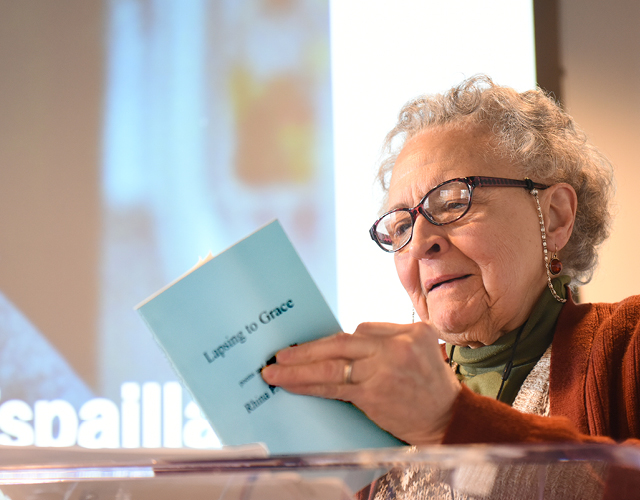
Distinguished Artist and Scholar in Residence Rhina Espaillat introduces audience to the “nine muses” and what they bring to one’s creative and/or teaching process.
The questions guiding the Institute, built on the strong foundation of the 2019 Center for Equity and Cultural Wealth Institute, “Power and Place: Valuing Cultural Wealth to Advance Equity in Higher Education,” included:
- How do we empower learning through the arts?
- How can we employ community-oriented, place-based teaching activities that integrate arts into any discipline?
- What opportunities can we find to lay the groundwork for future collaboration with artists and colleagues?
- What tools do we need to use art to support the development of identity, cultural wealth and cultural competence in ourselves and with our students?
The first day of the Institute focused on encouraging participants to think creatively about the many ways the arts can open up spaces for teaching and learning, honoring the experiences and strengths students bring. The second day challenged participants to plan activities, assignments, and syllabi that connect arts to equity outcomes by recognizing that arts can facilitate a deep and honest sharing of identity.
DAY 1: Stimulating Creative Thinking

Associate Professor Ashley Paul leads workshop on Visual Thinking Strategies.
Yvette Modestin, a poet, activist and founder and executive director of Encuentro Diaspora Afro in Boston, was the keynote speaker on day one. Her highly interactive presentation, “Unmasking Through the Arts,” began with a poem celebrating Blackness. She then challenged the BHCC community to recognize the centrality of identity in our work. Modestin spoke of the power of art to make people—even those who are resistant to our messages—listen, because art can be a non-threatening medium that compels people to engage and pay attention.
Faculty spoke openly about their own identities and experiences. Modestin then led a writing exercise on the prompt “I want to go where….” and facilitated a group poetry reading. She culminated the workshop as she began it, by performing one of her inspiring poems.
Workshops that followed Modestin’s keynote echoed and further developed her themes. Maddu Huacuja, whose artwork was featured this winter in the Mary L. Fifield Art Gallery, and Lloyd Sheldon Johnson, Ph.D., Professor Emeritus, Psychology and English, spoke on “Opening the Way to Learning in Gallery Spaces,” sharing their collaborative experiences when Johnson brought his students into the gallery to learn with Huacuja. Johnson asked, “Is there an artist in everyone?” Responses from faculty fortified the belief that there is. Huacuja closed the event by connecting the work of artists to that of educators, saying, “The key to teaching is to listen. Pay attention to who you’re talking to and everything changes.”
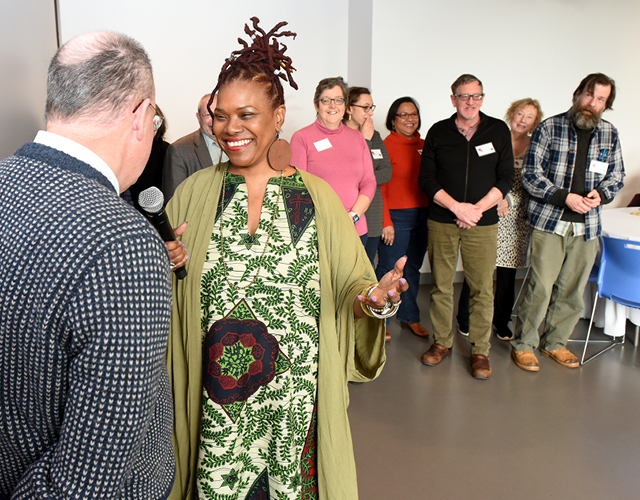
Poet and activist Yvette Modestin invites BHCC faculty to speak openly about their identities and their experiences.
In her workshop on “Visual Thinking Strategies,” Ashley Paul, Associate Professor of English, encouraged the use of open-ended questions and paraphrasing techniques to encourage group dialogue, evidence-based reasoning, and validation of prior knowledge in teaching. Cynthia Woo, the inaugural Pao Arts Center Director, discussed the history, resources and upcoming events at the Pao Arts Center.
After lunch, organizers set up an “Idea Fair,” during which participants could move around seven tables to learn about different approaches to integrating arts into the curriculum through small group and one-on-one conversations with experienced practitioners. Representatives from the Office of Community Engagement and the Office of Learning Communities along with arts faculty members Yong Chen (Visual Art) and Riikka Pietilainen-Caffrey (Performing Arts) shared their resources and offered hands-on creative activities.
Faculty members from other departments discussed artifacts of their arts-integrated teaching and learning. Shana Berger, Aurora Bautista, Jackie Kerstner, Robert Whitman, Ashley Paul and John Fiske each explained how place-based learning, field study, collaboration with artists, and arts informed pedagogy shape learning in their courses.
Arts integration specialist Marianne Adams from Lesley University’s Center for Advanced Professional Studies gave helpful advice on professional development in arts-integrated teaching at every level and in every discipline. The format allowed participants to make concrete connections to their teaching in the upcoming semester and to the themes of the second day.
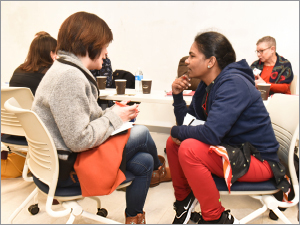
BHCC faculty Naoko Akai-Dennis and Bhanumathi Selvara connect in conversation during a workshop session.
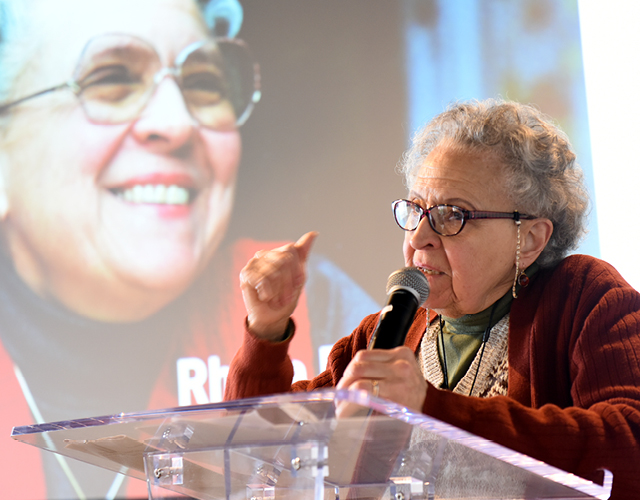
Espaillat delivers Day 2 Keynote on the “Nine Muses.”
The second day began with a series of back-to-back workshops, each building on and expanding the themes of the previous day. The first, “Connecting Culture and Equity Outcomes,” was an interactive panel discussion and presentation led by Shana Berger, Yong Chen, Jackie Kerstner and Isaias Sarmiento, and facilitated by Aurora Belina Bautista. In this session, panel members discussed concrete ways they integrate outcomes related to cultural wealth and equity in their classrooms and specific assignments.
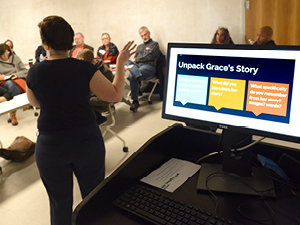
Cheryl Hamilton presents “Suitcase Stories” on the experiences of refugees and immigrants in the U.S.
Each briefly presented a lesson from their course and provided an opportunity for participants to ask questions. The varied backgrounds of the presenters—mathematics, English, ESL, and visual arts—was helpful in demonstrating how cultural wealth and equity can be integrated into classrooms of every discipline. Bautista pointed out these ideas are also part of BHCC’s Institutional Learning Outcomes.
Also that morning, Laura Carty Barrett led “Learning Communities 101,” a presentation and discussion for faculty who have not yet taught a learning community cluster or seminar. Barrett provided a brief overview of learning communities and how they are implemented at BHCC. The bulk of the workshop was devoted to planning a mock learning community cluster or seminar, based on some “on the spot” brainstorming. Faculty members had a lively and interactive discussion, and several mentioned they had an idea for a proposal after this exercise.
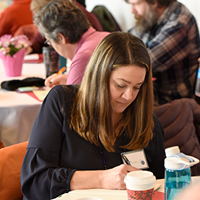
English Professor Laura Carty Barrett participates in writing exercise during Modestin’s Keynote
Cheryl Hamilton offered her workshop on “Suitcase Stories” during both of the morning sessions. Suitcase Stories® is a program of the International Institute of New England that aims to raise “the profile of refugees and immigrants while strengthening community through the art of storytelling,” according to its website. Hamilton used her workshops to engage faculty in storytelling exercises, which demonstrated how combining art and the personal narrative can be a powerful tool in the classroom.
Rhina Espaillat, BHCC’s 2019-2020 Distinguished Artist and Scholar in Residence, delivered the second keynote. After retiring from teaching English at the secondary school level in New York City’s public schools, Dominican-born Espaillat has devoted herself to writing poetry, short stories and essays in both English and Spanish, translating between both languages, running workshops for students and adults, and serving as visiting poet at colleges and other cultural centers.
Espaillat’s presentation explored what she called the “nine muses.” After distributing a handout describing each muse and what it might bring to one’s creative or teaching process, she asked participants to think about which muses they might “invite” to their class and what each one would provide to students. Espaillat also discussed how thinking of academic disciplines as arts or science is a relatively modern phenomenon, and suggested it might be useful to think of all classes—even history and physics—as arts.
After the keynote, the rest of the afternoon was offered as unstructured time for faculty to collaborate and discuss potential ideas, courses and assignments. Learning Community Think Tank members were available for advice and assistance, and many faculty members used the time to engage in informal discussion.
-—Yvette Modestin
The Institute provided faculty with many opportunities to engage with the primary guiding ideas of incorporating arts- and place based learning, and developing ideas of cultural wealth, cultural competence, and identity in our students and ourselves. The keynote speakers reinforced these ideas and inspired faculty to think of new ways to integrate the arts into their classes and to interact with students and each other. The workshops provided hands-on experience and the opportunity to engage with more seasoned Learning Community faculty, and the Idea Fair encouraged participants to explore areas of personal interest in an informal and more intimate manner. The unstructured collaboration time at the end of the institute allowed everyone to reflect on the previous days events and presentations and apply the ideas to their assignments or syllabi, to invite the muses into their teaching. Espaillat concluded her talk with a reading of her poem “Calculus,” which reminds us of the connecting power of the arts.
Article contributed by Jenne Powers, Director, Learning Communities, and Laura Carty Barrett, Professor, English.

Calculus
"Look," said my son, "think of it as a line
looped back and forth to bridge an open space
unbridgeable at last, but narrowed fine
and finer with each passing of the lace
almost to zero, which can never be."
"Why not?" said I. "That would be certainty,
absence of error. It would be too much
to hope for." "Then you orbit round your aim,
seeking, like Moses, what you'll never touch;
or like a poet, hunting for the word
to reproduce a song he thinks he heard
and send it hunting in the hearer's mind."
"Right," laughed my son, we play the self-same game.
Sometimes I think the game is all we find,
whether we search for song, or sign, or zero."
In the still house we talked into the night
before I left him, stalking, unafraid,
some stubborn truth flicking its dragon tails
across the page before him... my young hero
so thinly armored in the flesh I made,
my small moon gone so far and grown so bright
above my gaze, lighting his awesome skies
where I can wield no sort of telescope.
Pondering now what love could be, that fails,
as fail it must, to seize the flying prize
and yet endures, cradling the heart like hope,
I tell my son, "Think of it as a line
weaving between your orbiting and mine."
–Rhina P. Espaillat
“Calculus.” Lapsing to Grace: poems and drawings by
Rhina P. Espaillat, 1992. Used with permission of the author.
Building Connections on Campus
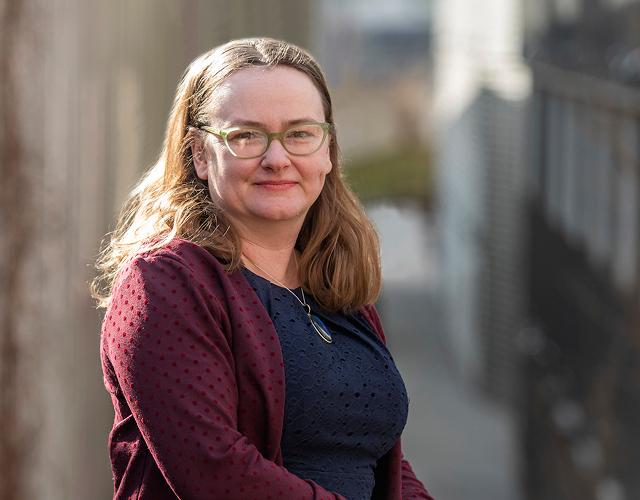
Director of Learning Communities Jenne Powers
Director of Learning Communities Jenne Powers
Jenne Powers brings more than a decade of experience in program design, assessment and faculty development to her role as Director of Learning Communities at BHCC. She served as both Director of the Writing Center and First Year Seminar coordinator at Wheelock College. In those roles, she oversaw a comprehensive assessment of Writing across the Curriculum and redesigned the First Year Seminar around interdisciplinary approaches to social and economic justice, including equity oriented student success models that integrated both advising and academic support into general education classes.
In her role at BHCC, she hopes to strengthen the already robust Learning Communities program through greater interdisciplinary connections as well as program and discipline-specific learning opportunities. In both of these areas, she hopes that students will see themselves and their experiences reflected in Learning Community themes and faculty. Co-organizing the January Institute “Empowering Learning Through the Arts” afforded Jenne a fantastic opportunity to showcase the work our faculty are doing around integrating arts and equity outcomes into their teaching.
Jenne also brings experience as a faculty member who has taught college writing classes, Russian and transnational literature, and social action writing classes at Wheelock as well as Boston University and Bentley University. Jenne has a Ph.D. in Russian literature and taught English in Russia before beginning her career in higher education.

